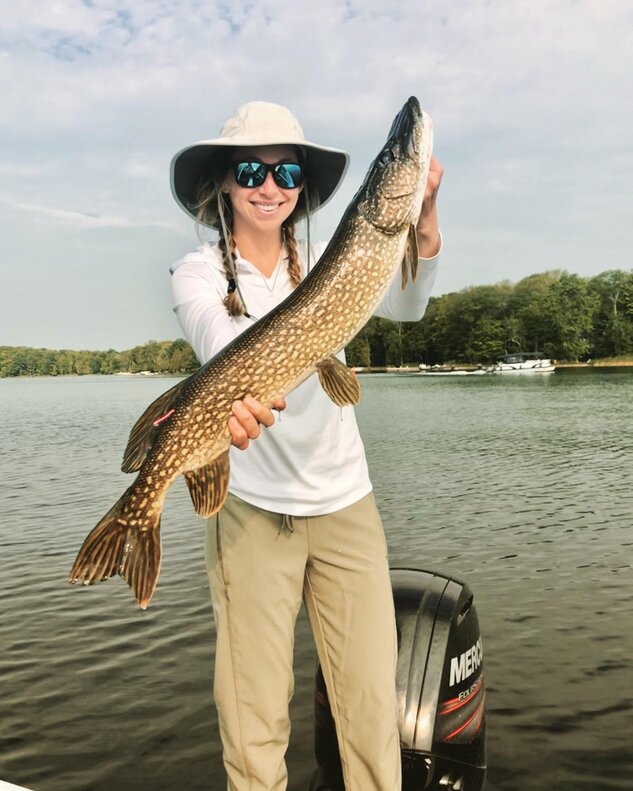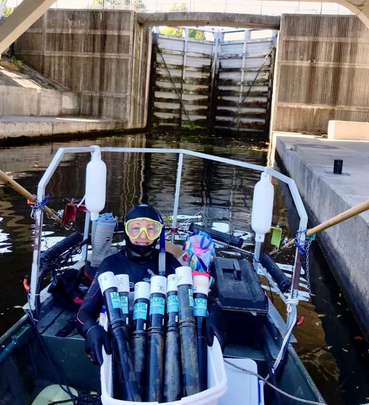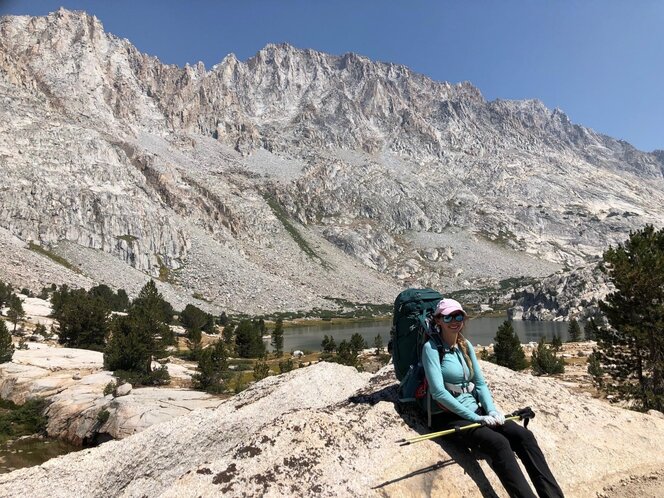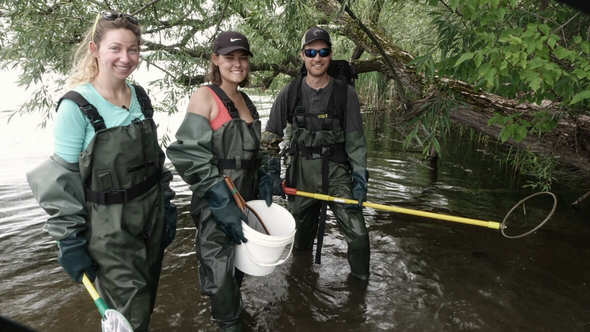
The northern pike (Esox lucius) is one of my favorite study species. We have 110 individuals acoustically tagged in the system and close to 800 externally tagged with FLOY tags. I had to snag a photo of this beautiful, tagged fish (note the pink tag near the dorsal!) before quickly returning it to the water. Animal welfare is of utmost importance to us, so we do our best to keep air exposure minimal – especially during warm summers, it’s best to keep pictures quick and fish in the water.
We held a Q&A with aquatic ecologist and conservation scientist Jordanna Bergman to get to know more about her and her research on freshwater fish.
Jordanna is also one of SCB's 2021 Graduate Student Research Fellowship award winners. This award supports field work, including travel, materials or equipment, required to conduct research by graduate student members.
It is thanks to our members that SCB can support students doing such important work to advance the science and practice of conserving Earth's biodiversity.
Tell us a little bit about yourself.
Hi! My name is Jordanna Bergman and I’m an aquatic ecologist and conservation scientist currently based out of eastern Ontario, Canada. I’m a dual Canadian-American citizen and have had the privilege to live, work, and learn across various places in North America. Before travelling to Canada for my PhD, I lived in Florida for 15 years where I completed my BSc at the University of South Florida and thereafter worked for three years as a marine fisheries researcher at the Florida Fish and Wildlife Research Institute. My past research experiences have been diverse – I’ve worked as a kelp forest ecologist in British Columbia, a professional diver in the Virgin Islands, and a Divemaster and Trainer at an aquarium in Florida. Though I was always set on pursuing a career in conservation, the exact taxa or environment was unclear to me; it’s safe to say I’ve ‘dipped my toes’ in a variety of conservation-focused positions in search of which avenue I might be most interested in focusing my efforts towards. It’s been a privilege to hold these past jobs, and although they did provide me with a strong scientific background, graduate school has offered a special chance to continue to learn and grow as a researcher, and person. Upon learning about the drastic biodiversity declines occurring in freshwater ecosystems compared to marine or terrestrial environments, I decided to turn my attention towards protecting our world’s precious freshwater systems for my PhD. For my thesis, I am investigating the ecological connectivity of a freshwater, historic canal as experienced by both native and invasive fish species to inform management strategies and conservation efforts. It’s been a pleasure to work in Ontario these past few years, and I look forward to working with the Canadian government to develop actionable plans to protect and restore biodiversity throughout the waterway.
What have been your biggest challenges in this research project?
One of the biggest challenges I’ve encountered is simply finding and capturing my study species! I work with several freshwater fishes, ranging from tiny round goby (Neogobius melanostomus) to meter-long muskellunge (Esox masquinongy). Muskellunge are known as the “fish of 10,000 casts” and they’ve certainly lived up to the phrase – I’ve been incredibly lucky to have support from our local Muskies Canada Inc angling chapter, members of which have come out several times to help me catch muskellunge (the beauty of community science!). Round goby, an invasive fish in Ontario, was discovered recently in the system I work in and because of low invasion-front densities, they were difficult to find and capture. Minnow traps are commonly used to capture them in other areas in Ontario, so we tried this method first. Everything failed: silver traps vs black traps, multigrain, white, and gluten-free bread, frozen and canned corn, cheese, hotdogs, leaving traps out day vs night vs 24-hour sets…we became excellent at catching crayfish, but alas no gobies. I decided after a few weeks to switch to backpack electrofishing, and electricity ended up being our magical solution to capturing them. When we did finally locate them, it was bittersweet – we were excited to have found them, but they were indeed an established, reproducing invasion front.
What is your favorite part about conducting your research here?
Ontario’s freshwater ecosystems are beautiful. I’ve been happy to spend my summers on the water conducting field work – hearing the loons (Gavia immer) call out while fishing, taking a quick dip on hot summer days, watching the leaves turn bright colors in the Fall – it’s a beautiful place to work. The system I work on, the Rideau Canal, is an inherently social-ecological system: it was constructed with human-use in mind (i.e., the ‘social’ aspect) and is still operated primarily for recreation today, however it also houses diverse biodiversity and several species at risk (i.e., the ‘ecological’ aspect). Thus, to evaluate fish connectivity in respect to anthropogenic barriers (like locks and dams) in the Rideau Canal, I’ve collaborated with experts in other disciplines, like social scientists and hydraulic engineers, and it’s been a favorite part of my thesis. Learning and collaborating with experts outside my field of expertise to develop the most integrative, comprehensive approaches to research questions has been rewarding.

I brave chilly Ontarian waters each May and October to deploy and retrieve our acoustic receivers. We deploy receivers bi-annually to ensure fish movements are being recorded year-round. The lockstation behind me is the Smiths Falls Combined Lock and is one of the few lockstations on the Rideau Canal that is electrically – not manually – operated.
What does a typical research/work day look like for you here?
For my thesis research, I use acoustic telemetry as a tool to evaluate the movement ecology of fishes in the Rideau Canal. Acoustic telemetry essentially has two components – acoustic tags (which we surgically implant into our target fish species; each tag emits a ‘ping’ with a timestamp and unique ID) and acoustic receivers (which are stationed underwater, waiting to ‘receive’ a ping from an acoustically tagged fish). In the field, we’re either fishing for target species and implanting acoustic tags, or I’m in the water free-diving in search of the receivers. The receivers must be retrieved every 6 months to be serviced, which makes for some fun – though usually cold, as I swim in April and October in Canada – time in the water! If I’m not in the field, I’m usually home or at a coffee shop digging into data, teaching, or writing.
What comes next? What are you working on now?
I recently had my first data chapter accepted with minor revisions – this is especially exciting for me. My first chapter used telemetry to evaluate movements and dispersion of the round goby invasion in the Rideau Canal, and our findings have important management implications. I’m working on my second chapter investigating muskellunge overwintering space use and movement patterns – there is a northern portion of the Rideau Canal that experiences drastic winter water drawdowns, likely minimizing suitable overwintering habitat for fish and potentially creating barriers to winter connectivity in shallower places. As we slowly emerge from the pandemic, I’m also quite excited to get back into the swing of conferences and connect with other experts in the field.
Where could we find you on any given Saturday? What do you like to do for fun?
If I’m not in the field, or analyzing data and writing (weekends don’t always exist for me, I’m usually at the mercy of good weather for field work!), I really love all things food-related. Baking, cooking, farmers markets, eating (obviously)…I enjoy trying new recipes and making fun meals and desserts. I also love the outdoors – I’m a long-distance backpacker and I’ve found that hiking has had considerable positive benefits for my mental health during my PhD. I have wonderful supervisors (Dr. Joseph Bennett and Dr. Steven Cooke) who have always been supportive of me taking off personal time to explore remote, wild areas. If I’ve learned anything over the past ten years, it’s the importance of finding a happy work-life balance and not letting myself get burnt out.

Each year, I try to take personal time to immerse myself in nature. My partner and I backpacked the 220-mile Nüümü Poyo, or John Muir Trail, and felt such privilege to spend a few weeks in California’s High Sierras. Even on “vacation,” the conservationist in me enjoyed learning about these high-altitude ecosystems and the species within them (the pika might have been one of my favorite new animals to see).
What are three things you always carry with you when in the field?
I am convinced research would never get done without duct tape, zip ties, and a multi-use tool. I am convinced I can make just about anything work with zip ties.
Why did you decide to study conservation biology? What was your path that led you here?
As a 10th birthday present, my father surprised me with a tropical introductory scuba course. I had quite an irrational fear of deep or dark water as a kid, so naturally, my initial response to this gift was pure terror. To everyone’s great surprise – including my own – I was absolutely captivated on my first dive. As we descended to a shallow 30 feet, I felt the warm water embrace me, and we gently drifted along a reef community teeming with an endless supply of lively, colorful animals. It captivated me. I later worked to achieve a professional diver status and have had the privilege to work as a Divemaster and scientific diver for universities, aquariums, and government organizations in Canada and the United States. Developing my skills as a diver led me to pursue careers focused on protecting our world’s aquatic environments and the species within them. To be quite honest, my expertise as a diver somewhat steered me to focus exclusively on aquatic environments; I believe, however, that a position focused on conserving trees or birds or terrestrial mammals would be equally rewarding for me. Because extinction rates are occurring more rapidly in freshwater ecosystems, and freshwater fishes are one of the most threatened vertebrate groups worldwide, I do feel I’m contributing my efforts towards an area that desperately needs our help (#TeamFreshwater!).

We used a backpack electrofisher to capture round goby in the Rideau Canal. My two research assistants that summer, André Killeen (right) and Brenna Gagliardi (middle), spent many hours with me wading through shallow, rocky habitats in search of round goby to acoustically tag and monitor. Because of our outfits and equipment, I used to tease and call us the “gobybusters.”
How did you choose to do this research project in particular?
In 2015, I worked as a scientific diver and research assistant at Simon Fraser University in British Columbia (BC), Canada. Our field work was located on the beautiful, remote Central Coast of BC where we partnered with the Heiltsuk First Nation to investigate potential effects on fish and invertebrate communities after harvesting the surface canopy of giant kelp at varying degrees of intensity. Our results had direct, tangible harvest and climate change implications. During this summer I had a key epiphany that slightly shifted the direction of my ambitions: I could see how the results from our kelp harvest project directly provided management and ecological information so that people could harvest a food source while maintaining the integrity of an ecosystem. Prior to this job I had conducted an undergraduate thesis where I focused more-so on theoretical science, and realized although I enjoyed the full process that is “research,” my heart was not quite in it. My time in BC, however, is when I discovered my passion for applied conservation science. As such, it was important to me that I find a PhD project where the results from our findings would directly support conservation actions and management strategies. I contacted upwards of 30 professors before I found my current position – so don’t give up too soon if you’re trying to find your “glass slipper” of projects. Ontario’s fisheries generate $2.2 billion/year for the provincial economy; the native fish I study are not only ecologically important as apex predators, but they are economically and recreationally of great importance too. Invasive species are a critical threat towards our native fisheries, so invasion biology was a field I was keen to get involved in as well. Knowing that results from my thesis will be used, or at the very least acknowledged, by the federal Canadian government feels like a step in the right direction to support real-world conservation actions. I look forward to supporting and enhancing Ontario’s economically-important, and beautiful, freshwater ecosystems, and am curious to see where life will take me next.